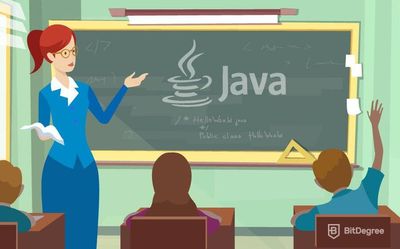Free Airdrop Season 7 is LIVE! Answer fun questions or do simple tasks to earn rewards from the $30K BitDegree prize pool. Participate Now ! 🔥
Working with databases can be a fickle business that requires some technical prowess. And if you feel like you’re jumping into unchartered waters here, don’t worry – DataCamp SQL courses can guide your way.
If you’re interested in a data analytics career or have to take over some database management tasks, it’s going to be pretty vital for you to learn to work with SQL. To make this learning experience more accessible for you, we’ve compiled a list of some of the best DataCamp SQL courses.
Of course, before we get into the courses themselves, we have to figure out a few things. What is SQL? Why is it pretty much the key component of database management? We’ll be looking at the usefulness of this language and how it makes it easier to work with data without getting overly technical – you’ll get to that in the actual courses.
Then, you’ll find out a bit more about the learning platform itself. DataCamp offers not just data science courses but also other interactive learning experiences, like projects and skill tracks. In fact, we’ll be looking at one skill track in particular.
The DataCamp SQL Fundamentals skill track has been designed to be a great entry point if you have no prior experience working with this language. We’ll take a look at the courses included in this track and see how you can get the hang of SQL faster than it’d take you to complete a university course.
So, let’s peek through the curtain and into the world of data analytics.
Table of Contents
- 1. Why Should You Choose DataCamp SQL Courses?
- 2. DataCamp Skill Tracks
- 3. Introduction to SQL (Enroll Here)
- 4. Joining Data in SQL (Enroll Here)
- 5. Intermediate SQL (Enroll Here)
- 6. PostgreSQL Summary Stats and Window Functions (Enroll Here)
- 7. Functions for Manipulating Data in PostgreSQL (Enroll Here)
- 8. Conclusions
Why Should You Choose DataCamp SQL Courses?
Firstly, let’s address the elephant in the room – what is SQL? The acronym stands for “standard query language”, making it slightly different from other programming languages that you might already be familiar with, like Python or R. It also happens to be one of the oldest programming languages in use, as it was developed back in the 1970s.
Latest Deal Active Right Now:Follow the Datacamp promo code link & get an exclusive 25% OFF Datacamp subscriptions. Act now while the offer is still available!
Given that it’s been around for nearly half a century, it’s unsurprising that SQL has gathered a significant community worldwide. It has not lost its popularity over the years, either. According to a StackOverflow survey conducted in 2021, SQL is the fourth most popular programming language, falling behind Python, HTML/CSS, and JavaScript.
Despite the decades, the syntax has remained more or less unchanged. It’s considered to be one of the easiest programming languages to learn as it uses simple English terms in its structure. However, it’s been recommended that you have some prior programming experience before diving into SQL.

SQL is a very flexible programming language. Although it’s primarily used for data management, you can also complete data mining and manipulation.
Even if you don’t have hands-on experience working with SQL yourself, you’ve certainly used products that utilize it in their databases. From small online shops to big names like Twitter, Spotify, or Netflix – they all use SQL to organize and store data.
SQL is a valuable skill to have under your belt if you’re looking for a role in data analytics or any adjacent fields. It’s a highly in-demand skill, so you’re likely to improve your opportunities to land your dream job. While there are tons of tutorials, video guides, and other ways to learn SQL, one of the best places to start is DataCamp.
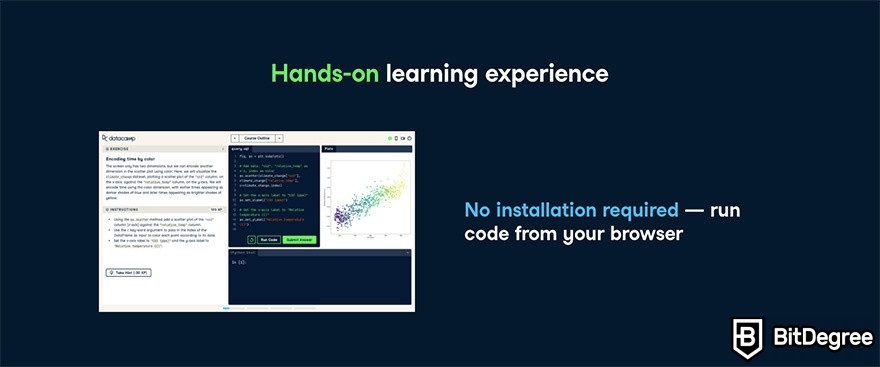
DataCamp is a learning platform that will help you develop your SQL skills and make you industry-ready in an informative and interactive way. The platform provides you with gamified education – you can complete daily missions, work on in-course exercises, and earn experience points that show off your progress.
If you want to learn more about the platform itself, you can read our review here. However, we’re here to discuss the DataCamp SQL courses specifically. The platform offers more than 20 courses with difficulties ranging from beginner to advanced. They focus on different aspects, from syntax to developing your own databases.
According to DataCamp SQL reviews, the courses are a helpful tool to develop your skills and learn how data management processes work in the industry. And if you need one more great reason to start learning on the platform, it’s the ability to learn through Datacamp SQL skill tracks. Let’s take a look at what they are and how they work.
DataCamp Skill Tracks
There are many different skills required in the field of data science. From the technical, like programming languages and software, to cognitive skills, like data literacy – data scientists must be well-rounded and highly skilled in their competitive field.
Once you’ve completed the basic training – perhaps an online course or two – you can suddenly become overwhelmed by every path you could take. Should you find your perfect niche, work on becoming the jack of all trades, or switch courses altogether? With DataCamp Skill Tracks, you can find a surefire trajectory to follow.

DataCamp Skill Tracks have been established to help budding data scientists and analysts to work on their skills progressively. There are around 50 skill tracks to choose from.
While the selection for DataCamp SQL skill tracks isn’t as large, with five tracks available at the time of writing, one of them is designed to suit the needs of complete beginners.
The DataCamp SQL Fundamentals skill track will guide you through the first steps into data management. The first course in this track is, fittingly, Introduction to SQL. Then, you’ll move on to other beginner-friendly tasks and reach the intermediate level before you know it. After completing all five courses, you’ll be proficient in SQL.
Let’s see what you’ll be learning once you choose to take the SQL Fundamentals track.
Introduction to SQL (Enroll Here)
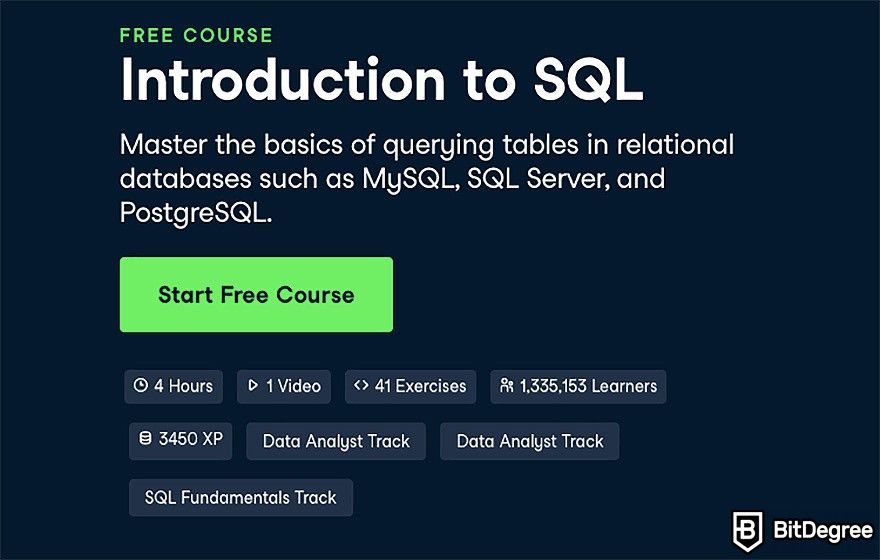
- Offered by: Nick Carchedi
- Duration: 4 hours
- Price: FREE
- Certificate: No
- Level: Beginner
- Where to apply? HERE
So, you’re brand new to the world of SQL. You know what it is and where it can be used, but the “how” is still a mystery. Everyone needs a starting point when approaching a new subject. And in the case of the DataCamp SQL Fundamentals skill track, that point is the Introduction to SQL course.
This course is as beginner-friendly as it can get. The onboarding process will help you understand even the more complex concepts simply, and you’ll be able to study in a fun, interactive way.
Simply reading theory in a textbook or watching a video that explains concepts without showing you how to do them yourself can get boring. There’s none of that with DataCamp. This course will offer you an opportunity to work on more than 40 exercises. So, you’ll be able to practice data management from day one.

This four-hour course consists of the following chapters:
- Selecting Columns
- Filtering Rows
- Aggregate Functions
- Sorting and Grouping
The first chapter will teach you how to work in the interactive learning environment. You’ll see the basics of using the syntax and working with tables. It’s both an onboarding to DataCamp if you haven’t taken any of the courses before and your first glimpse into how SQL works.
Once you know how to start your analysis, you can move on to filtering the tables based on your criteria. In the second chapter, you will learn to use basic comparison operators, like WHERE AND and BETWEEN. You’ll also see how to search for patterns – a filtering method often required in the real world.
Then, you’ll be introduced to the concept of aggregate functions. They are used to calculate values within the database. You’ll also see how aliasing works and how to make your data analysis results more readable.

In the final chapter of the DataCamp SQL course, you will manage the results of your data analysis by using sorting and grouping. This will help you present your results in an easy-to-follow format and filter out unnecessary information to get clear insights.
By the end of this course, you’ll be able to conduct a simple database analysis. With a combination of simple-to-follow theory and real-life data, it sets a great foundation for early SQL users. The DataCamp SQL reviews for this course have described it as very helpful to get started in your career.
This might seem like a lot of information to handle at first glance. But there’s no need to memorize everything at once. To save yourself time, simply access the DataCamp SQL cheat sheet based on the skill track. This cheat sheet has all the essentials you need in one place, so you won’t need to search around in your notes.
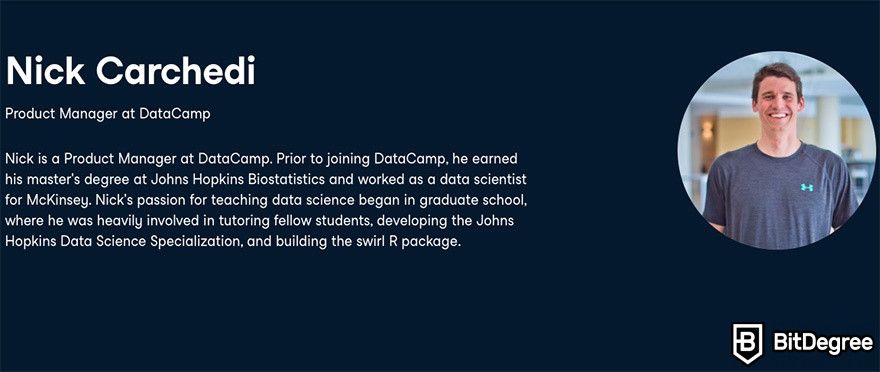
The Introduction to SQL course is taught by Nick Carchedi, DataCamp’s product manager. He is passionate about teaching data science and has experience working with R packages.
And here’s one more reason why you absolutely should not miss out on the DataCamp Introduction to SQL course – it’s free to learn. All you have to do is create an account and enroll in the course.
Introduction to SQL is one of the six courses available on DataCamp for free, so there’s no reason not to sign up and start working on your data management skills. And if you’re interested in DataCamp’s entire catalog with over 350 courses, you can subscribe to DataCamp Premium for $25/month.
Joining Data in SQL (Enroll Here)
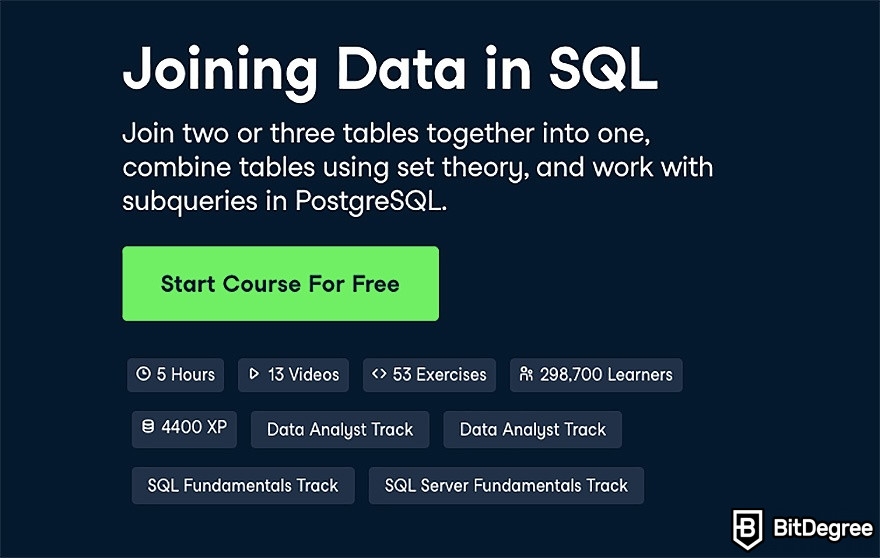
- Offered by: Dr. Chester Ismay
- Duration: 4 hours
- Price: from $25/month
- Certificate: No
- Level: Beginner
- Where to apply? HERE
So, you’ve got the very basics set, and you can do data analysis of a table. That’s great! It’s time to level up – in the real world, you’ll often deal with multiple, sometimes even up to a hundred tables at once. So, learning to join tables together to extract valuable data is the next thing on your SQL learning agenda.
The Joining Data in SQL course is designed to follow the Introduction course discussed above. So, it’s recommended that you complete Intro to SQL before jumping into this course. It’ll give you the required understanding of how to work with functions and complete basic data management tasks.
Joins, joins, joins. The name is self-explanatory, as the course covers just about everything you need to know about joining data for your analysis. Joins are one of the most important tools that you’ll need while working with SQL servers – the software used to execute SQL queries.
In addition to joins, you’ll be looking at a few other handy SQL tools, like intersections and except clauses. You’ll learn about set theory clauses and how they can be visualized using diagrams. Lastly, you will work with nested queries and see how they can be embedded inside other queries.

By the end of the Joining Data in SQL course, you’ll be able to:
- Differentiate between inner and outer joins;
- Apply self-joins to tables;
- Use left, right, full, and cross joints;
- Understand set theory using Venn diagrams;
- Create nested queries (subqueries);
- Know when to use different types of subqueries.
Don’t worry, these five hours won’t get boring. After all, DataCamp is not a theory-only platform. You’ll have access to tons of diagrams and examples that aren’t just easy to understand but, most importantly, based on real-world data. Besides that, you’ll complete more than 50 exercises and challenges that’ll put your skills to a much-needed test.
There’s a good amount of new queries that you learn in this course. To help you keep track of them, the DataCamp Team has created the Joins in SQL Tutorial. It’ll help you reinforce your new skills with user-friendly visual examples.
The author of this course is data scientist and R/Python consultant Dr. Chester Ismay. As an educator, he aims to make data science approachable to everyone. He has also authored the Programming with dplyr course on DataCamp, so if you’re also interested in learning R, you can find our overview of the DataCamp R Programming skill track here.
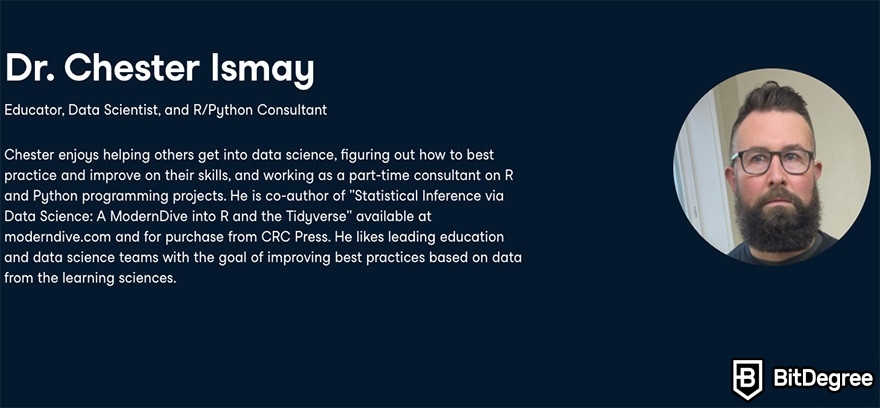
Start your introduction to joins with the first chapter of this DataCamp SQL course for free. And if you want to keep learning and working on even bigger projects, you can sign up for the DataCamp Premium plan for $25/month. Not only will you access all other SQL courses on the platform, you can also join fun projects that use real-world data.
Mastering this course will also put you one step closer to a data analyst career. If that’s something you’re interested in approaching, the Premium plan also grants you access to the DataCamp Certification programs.
Gain practical industry skills, get in touch with DataCamp’s career services team and build connections with DataCamp Jobs. Completing the Joining Data in SQL can open more doors for you than you might’ve ever expected.
Intermediate SQL (Enroll Here)

- Offered by: Mona Khalil
- Duration: 4 hours
- Price: from $25/month
- Certificate: No
- Level: Intermediate
- Where to apply? HERE
Two courses in the DataCamp SQL Fundamentals skill track down, three to go. It’s time for you to level up and jump into the intermediate level of SQL. That’s exactly where this next DataCamp SQL course will take your skills.
The Intermediate SQL course is here to help you grow your technical skillset. The goal is for you to master the art of analyzing data by creating robust data sets that use multiple tables within a relational database. You’ll start working with different data manipulation strategies.
Some of the main tools you’ll be learning about are different types of subqueries, the CASE statement, and window functions. The entire Intermediate SQL course uses examples of data extracted from the real world – if you happen to be a soccer fan, you’re in for an exciting challenge.

The chapters you’ll be covering in the four-hour Intermediate SQL course are:
- We'll take the CASE
- Short and Simple Subqueries
- Correlated Queries, Nested Queries, and Common Table Expressions
- Window Functions
The first chapter will introduce you to CASE statements. You will test multiple logical conditions using the CASE statement with different clauses to refine your data results and receive more accurate information. This is one of the filtering mechanisms that you’ll often require in data management.
In the second chapter, you’ll learn about subqueries and how they can transform the data you’re working with. You should already be familiar with the concept of subqueries from the Joining Data in SQL course, so this chapter won’t be too unfamiliar to you. You’ll get the opportunity to build on your knowledge and keep your skills from getting rusty.

The third chapter stays on the topic of subqueries and shows you how to make more complex constructions – correlated subqueries. They are used as an advanced data joining and filtering tool that will help refine your results.
Finally, you’ll see how window functions work. They’re used to conduct calculations on windows – results sets that have been generated. This will save you time from grouping data. You can also use window functions to calculate rankings, moving averages, and running totals.
The Intermediate SQL course is taught by Mona Khalil. Mona is a data scientist who has experience working in education, so you’ll be learning from an expert who doesn’t just know what skills you’ll need in the industry, but also how to teach them effectively.

By the end of the Intermediate SQL course, you’ll be able to conduct more defined analysis and have a better understanding of data manipulation. As Mona says in one of the chapters: it might seem complicated at first, but all it takes is a few examples and some practice to get the hang of everything you’ve learned.
And don’t forget – you can always have the DataCamp SQL cheat sheet at hand. It was built around the SQL Fundamentals skill track and has everything you need to know about working with this query language. It’s a convenient tool that will help you work on your data projects with ease.
You can venture into the first chapter of the Intermediate SQL course for free. The rest of the course is available with the DataCamp Premium plan for $25/month. It’ll unlock access to the entire range of DataCamp SQL courses, as well as other programming languages and digital tools, like Python, R, and Tableau.
PostgreSQL Summary Stats and Window Functions (Enroll Here)
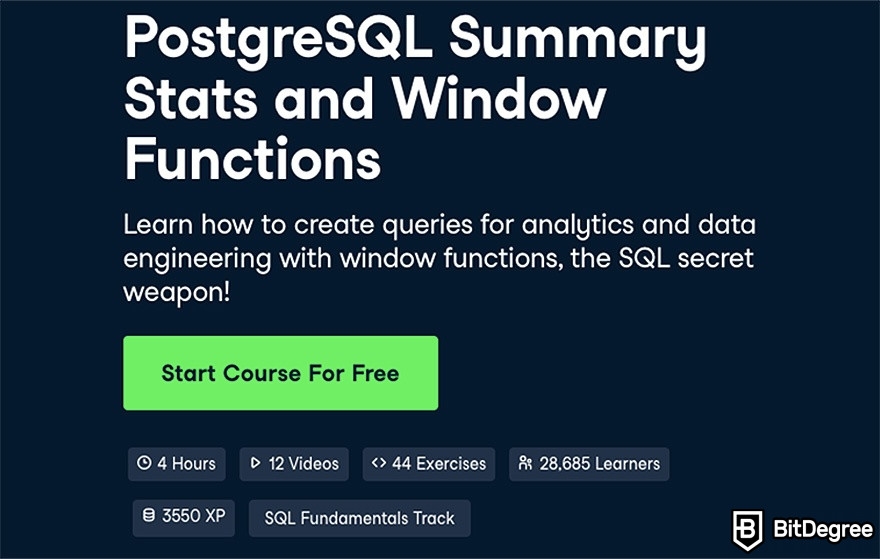
- Offered by: Fernando Gonzalez Prada and Michel Semaan
- Duration: 4 hours
- Price: from $25/month
- Certificate: No
- Level: Intermediate
- Where to apply? HERE
There are probably two goals you have in mind when you sign up for an online course like the DataCamp SQL Fundamentals skill track. The first, of course, is to gain knowledge about the programming language, how it works, and what its structure is.
The second goal is to see how this knowledge can be applied in practice. While having the formulas and examples in front of you is a useful learning tool, it won’t be enough out there in the real world. Having access to real-world data and industry strategies can help your skills grow faster.
That’s what the PostgreSQL Summary Stats and Window Functions course is here to help you with. Don’t let the long name intimidate you – as every course on the track, it builds on the skills you’ve already gained. The goal is for you to see how SQL can be used to solve business problems in the real world.

This course will help you refine the way you write your queries. You will add new skills to your toolbox, including calculations, data deduplication, and time intelligence, that will make data analysis results more sophisticated.
While you should already be familiar with the concept of window functions from the Intermediate SQL course, here’s where you’ll be looking into its broader applications. In fact, it’s described as SQL's secret weapon – a tool that will save you time and condense the calculations of running totals and row values to just one function.
Throughout the four hours of this course, you’ll complete more than 40 query-based exercises that will help you get the hang of window functions. It’s going to be particularly useful if you’re interested in data engineering and analytics.

By the end of the course, you’ll be able to:
- Define window functions and subclauses;
- Fetch values from the data table;
- Rank the table rows based on their values;
- Use aggregate functions as windows functions;
- Define the frames of moving averages;
- Use pivoting to make ranking data more scannable.
Your primary database for this course is based on the Summer Olympics medal statistics. You’ll be able to write your own queries based on the theory to calculate the results and get a look into how you’d use window functions in your future projects.
The course aims not just to teach you how SQL queries work but how to simplify them. There are many shortcuts and ways to speed up the data analysis process, so you’ll know what the simpler road is and what toolkits professionals use.

The PostgreSQL Summary Stats and Window Functions course was created by two instructors – data scientists Fernando Gonzalez Prada and Michel Semaan. They bring their combined expertise in the data science field and business analytics to provide you with insights into how SQL helps companies manage data in practice.
The first chapter of this DataCamp SQL course is available for free. But if you’ve been following the skill track, it shouldn’t come to you as a surprise that the DataCamp Premium plan is worthwhile. For $25 a month, you can access more than 350 courses, an ever-growing list of real-world projects, and competitions with significant rewards.
Functions for Manipulating Data in PostgreSQL (Enroll Here)

- Offered by: Brian Piccolo
- Duration: 4 hours
- Price: from $25/month
- Certificate: No
- Level: Intermediate
- Where to apply? HERE
You’ve come to the final course of the DataCamp SQL Fundamentals skill track. You know how SQL works and how to use the queries to conduct your analysis. There’s one thing you haven’t taken a very deep look at yet, though – SQL databases.
The Functions for Manipulating Data in PostgreSQL course will reveal the capabilities of one of the most popular open-source databases – PostgreSQL. It’s a free database management system that is used as a primary data storage for various applications and systems, including the macOS server.
In this four-hour course, you’ll learn the key functions that you will require to manipulate, process, and transform data on PostgreSQL. You will also see how the full-text search function works on the database. It’ll help you index keywords on PostgreSQL documents easier.

In addition to these tools, the course will also show you some of the most useful PostgreSQL extensions that will make data sorting even easier. These extensions will allow you to create your own custom data types and functions.
The chapters that you’ll be studying are:
- Overview of Common Data Types
- Working with DATE/TIME Functions and Operators
- Parsing and Manipulating Text
- Full-text Search and PostgreSQL Extensions
You’ll start off by exploring the common data types – strings, numerics, and arrays. Understanding the different data types, their properties and characteristics will make it easier for you to retrieve information about the database you’re using.

Then, you’ll get more hands-on experience with data manipulation. You’ll work with DATE/TIME functions to perform calculations and extract necessary subfields. As part of the challenge, you’ll go through the full process of calculating, manipulating, and extracting the date/time data.
In the third chapter, you’ll move on to text data manipulation. You see how strings and text data can be parsed and transformed. You’ll also learn how to extract substrings from larger strings.
The final chapter of the course – and the whole DataCamp SQL Fundamentals skill track – will introduce you to some of the recommended extensions that you can use in PostgreSQL. You'll be able to customize your data analyses and create your own convenient process. You’ll also look at the full-text search functionality in the database.

This course is taught by Brian Piccolo, a digital executive and entrepreneur. He has years of experience in software development and product management. He brings his diverse experience with digital products and strategies to help you gain a more practical understanding of SQL databases.
If you plan to keep exploring the PostgreSQL database on your own, take a look at the DataCamp SQL cheat sheet. It provides examples for the most important functions included in the DataCamp SQL Fundamentals skill track and even recommends PostgreSQL as one of the best tools to develop your skills in practice.
You can have a sneak peek into the Functions for Manipulating Data in PostgreSQL course and access the first chapter for free. But with the Premium plan, you can finish the DataCamp SQL Fundamentals track and access every other learning opportunity available for $25/month.

Did you know?
Have you ever wondered which online learning platforms are the best for your career?
Conclusions
Congratulations! You’ve finished your SQL Fundamentals journey. You now have the essential skills required to successfully work on data analysis and manipulation projects. You can let us know about your experience by writing a DataCamp SQL review below.
Now, you’re ready to journey into the big SQL field. If you still feel a bit shaky, feel free to take one of the SQL skill assessments on DataCamp completely for free. They’ll let you determine your abilities and see the progress you’ve made from day one.
And even if you find yourself falling a bit short of your expectations, the entire DataCamp SQL course catalog is at your disposal. The data science world is your oyster.
So, why wait? Join DataCamp today and start taking the Introduction to SQL course for free or enroll in any other course or project for just $25 a month with the Premium plan. The value is not just in what you learn, but what you’ll put to use in your life. Your brand-new data science skills certainly won’t go to waste.







